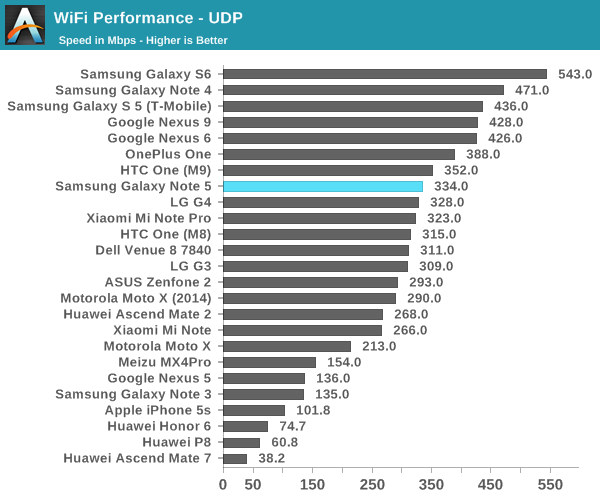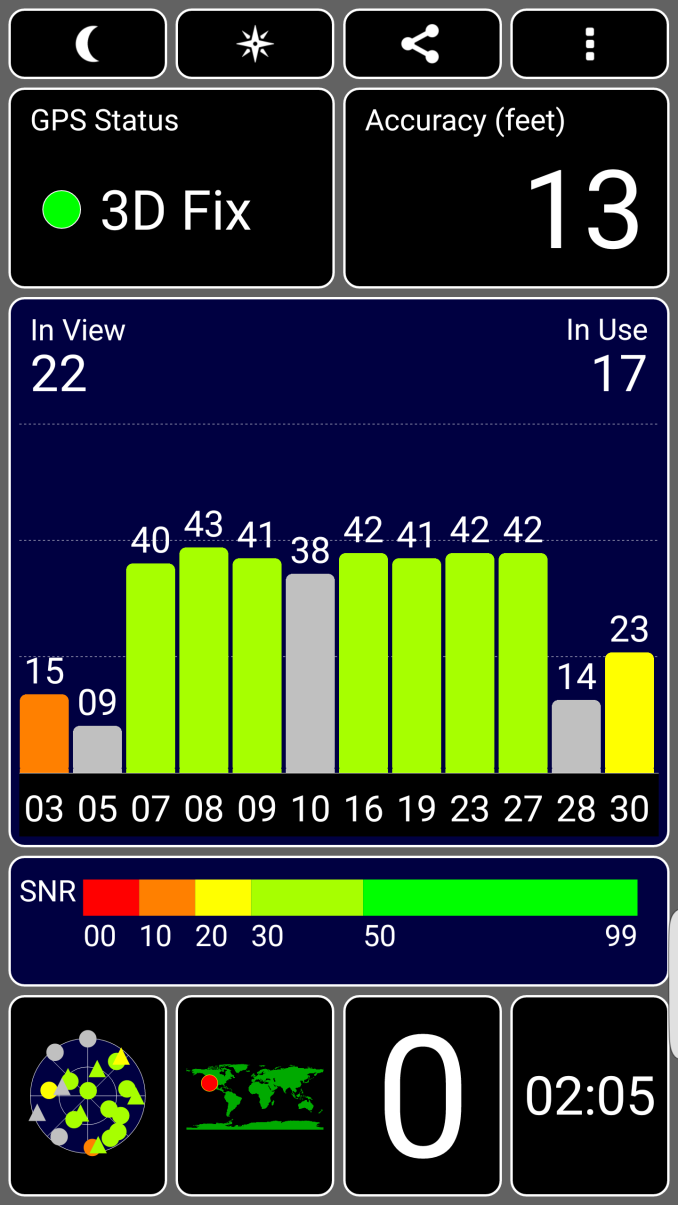The Samsung Galaxy Note5 and Galaxy S6 edge+ Review
by Joshua Ho on October 2, 2015 8:00 AM ESTVideo Performance
Now that we’ve taken a look at still image performance, we can look at video performance. For the most part these results should be similar to still image performance, but we’re looking at encoder efficiency, good sound recording, and effective stabilization. The Galaxy Note5 and Galaxy S6 edge+ both have OIS in order to improve stability in video recording, and for the most part the feature set of both is similar to the Galaxy S6 when it comes to video.
Galaxy Note5
Galaxy S6
Galaxy Note5
iPhone 6
For 1080p30, Samsung has elected to use 17Mbps High Profile H.264, along with a 256 Kbps stereo audio channel encoded with AAC. If this sounds familiar, it's because this is shared with the Galaxy S6. Quality is indistinguishable. Unfortunately, it seems the same sort of jerky OIS reset effect is still present although it isn't too obvious in these videos.
Galaxy S6
iPhone 6
It probably goes without saying, but once again the Galaxy Note5 shares the same video encode settings with the Galaxy S6, with 28 Mbps High Profile H.264 encoding for 1080p60 video. In these samples you can more clearly see the issues that come with OIS in video, which is that there are instances of jerky video movement when it should be relatively smooth, even if it's shaky. The only real difference between the Galaxy S6 and Note5/S6 edge+ is that the Note5 removes a bit of the yellow tinge/saturation boost that we see in the Galaxy S6. There's otherwise relatively little to comment on here.
Once again, not much is different when comparing the Galaxy Note5 and Galaxy S6 edge+ to the Galaxy S6 other than saturation differences in some cases. The same encoder settings are also used for 48 Mbps HP H.264 with 256 Kbps AAC stereo audio.
Galaxy Note5
Galaxy S6
Galaxy Note5
iPhone 6
If you're able to read the trend, you can probably guess that the Galaxy Note5 and S6 edge+ are going to share the same encode profiles as the Galaxy S6, which is 48Mbps HP H.264. Once again, quality is effectively identical here and the changes are slim to none. This unfortunately means that the iPhone 6 still leads here as the quality of the slow motion video on the Galaxy Note5 and Galaxy S6 line weren't much good to begin with.
WiFi Performance
For the most part, it probably goes without saying that one of the cornerstones of a smartphone or phablet is mobile data. After all, without mobile data you’re effectively limited by whatever WiFi hotspot you can find, which is often limited in range. Comparatively speaking, mobile data is generally more versatile. However, in the case of most mobile devices WiFi is often used at home in order to utilize a normally lower-latency connection with generally higher throughput. Given the reality of data caps, WiFi is also often needed for things like app updates, video streaming, and possibly music streaming. As a result, poor WiFi can sink a phone. In order to try and get a basic measure of performance, we look at peak UDP bandwidth using iPerf. In the case of the Galaxy Note 5, Samsung has upgraded the WiFi chipset from the BCM4358 used in the Galaxy S6 to Broadcom’s BCM4359. This is supposed to allow connections to 2.4 and 5 GHz WiFi simultaneously, but in practice it doesn’t really look like it’s used outside of potentially faster scanning.

Interestingly, I was unable to get the download speeds that I was expecting from a 2x2 802.11ac WiFi solution despite using 5 GHz. It's possible that this is due to interference as I can't isolate the system from other WiFi hotspots in the area, but in my experience I never had any real issues with WiFi that I could notice. Reception doesn't seem to be any better or worse than other devices I've tried in recent memory.
GNSS Performance
GNSS is often critical to a mobile device these days, as a number of applications rely on highly accurate location in order to work properly. Probably the most obvious case here is going to be GPS navigation, but things like lost/stolen device location, geofencing, location-based check-ins, and other applications are all generally quite reliant on accurate location that only GNSS systems can provide. In the case of the Galaxy Note5 and Galaxy S6 edge+, we see that the GNSS module is shared with the Galaxy S6 for the Shannon modem variants as a BCM4773 GNSS location hub is present within the system.
In practice, I didn’t find much wrong with this solution. Time to first lock without any assistance data took about 30 seconds, and at the 46 second mark the maximum possible accuracy was achieved. With assistance data, a position fix was reported within 5 seconds of launching the GPS Test app. Overall, I doubt anyone will face any real problems dealing with GPS/GNSS location on these devices.











225 Comments
View All Comments
Le Geek - Friday, October 2, 2015 - link
I am curious as to why you referred to the new Note as the Note5 (without space) but the previous note was called Note 4.Ryan Smith - Friday, October 2, 2015 - link
That is the official name according to Samsung. It was the "Note 4" and for this iteration they've removed the space so that it's the "Note5".http://www.samsung.com/global/galaxy/galaxy-note5/
We typically follow the manufacturer's naming convention unless there's a problem in doing so.
danbob999 - Friday, October 2, 2015 - link
"With this generation of AMOLED, Samsung has definitely equaled the best LCDs on the market. I suspect within the next year or two it will be inevitable that Samsung AMOLED will be clearly superior to even the best LCDs"Anandtech has been saying this for years.
Kuzi - Saturday, October 3, 2015 - link
Except that in reality Amoled surpassed LCDs since 2014.Anandtech will not admit Amoled is great until Apple starts using it in their devices (my guess is next year). Of course Apple would bump up the resolution and give it a fancy name, and Anandtech will sing the praises of how amazing Apple's Amoled is. When in reality the screen panel will be made by Samsung or LG :p
PPI will become important and talked about by Anandtech again only when Apple bumps the resolution.
Peichen - Monday, October 5, 2015 - link
If AMOLED is anywhere close to IPS why aren't EIZO, NEC, Dell switch their professional lineup to AMOLED? Why are 31" calibrated IPS monitors going for $3000 while the same money can get you 55" 4K OLED TV?Just because your eyes cannot see the difference doesn't mean professionals cannot. That goes for your rant vis-a-vis iPhone.
Kuzi - Tuesday, October 6, 2015 - link
You can't compare Professional monitors with TVs. If these Dell. NEC monitors were using OLED technology then probably they would have cost double the amount.Also keep in mind that color accuracy of the Samsung OLED screens only became comparable to the best IPS LCDs since a year ago or so. So these manufacturers didn't get the chance yet to move to OLED. There are only cost and capacity considerations, it might be that Samsung is keeping all the capacity for themselves at this time.
Don't be surprised when in a year you see Apple move to OLED.
thedons1983 - Sunday, October 18, 2015 - link
LCD is crap compared to OLED, or AMOLED, there is no denying that, and those who don't buy into that fact, are utter morons. The reason they aren't yet ubiquitous, is cost. Every display will eventually replace LCD, with something superior, like OLED. Hence why top end Tvs are now transitioning to that tech, because it is simply much, much better technology. Apple just can't afford it, hence why they persist with inferior tech.Dobson123 - Friday, October 2, 2015 - link
Maybe it would be a good idea to address concerns regarding battery durability and quickcharge in the light of the non-removable battery. What should I do if my battery lost half it's capacity after 2 years? A normal user just can't buy a new on and change it himself.Peichen - Monday, October 5, 2015 - link
I'd like to know this as well. Maybe someone can go crazy and charge and discharge popular smartphones using its default charger for 100/200 cycles and run the same battery test to see if there are obvious signs of battery degradation.An iPhone 6s+, Z5, V10, Note 5, Moto X, Oppo something.
Infy2 - Friday, October 2, 2015 - link
Is the maximum display brightness reported here achievable simply with the brightness slider or just with the boost feature triggered by direct sunlight?